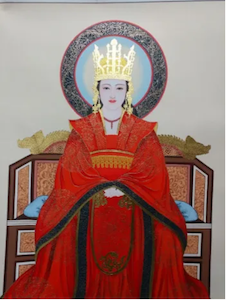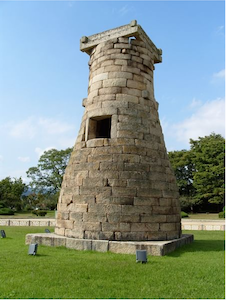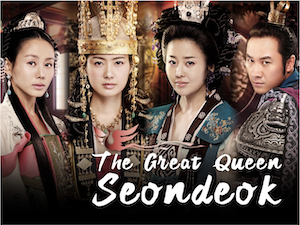
Queen Seondeok of Silla ruled as ancient Korea’s first female ruler and was a transformative figure who made notable progress to Silla, which later became a dominant Korean kingdom. Not much is known about her early life, however it is widely known that she was born around 606 AD to King Jinpyeong, the 26th king of the Silla kingdom and his first queen Maya. Raised in a family of royalty, she was initially known as Princess Deokmen before she achieved her queendom. In addition, her position is partially attributed to the fact that none of King Jinpyeong's official queens ever had a surviving boy even though multiple of his royal concubines had sons. Conversely, Queen Seondeok possibly had two sisters, Princess Cehonmyeong and Princess Seonhwa, whose ages are unknown. From a young age, Seondeok was known for her exceptional intelligence, a critical trait that distinguished her and prompted her father to foresee her as the most capable successor to the throne. Furthermore, her remarkable intellect can be manifested through a notable tale from her youth; Emperor Taizong of China sent the princess a box of poppy seeds and a painting of the flowers. After planting the seeds and observing their growth, Princess Deokman claimed the flowers looked pretty, but it was a shame that they did not smell. She reasoned that if the flowers could smell, butterflies and bees would surround them. Once bloomed, the flowers did not have an odor. Subsequently, this anecdote serves as a testament to her foresight and is another example of why her father praised her brilliance.
Since Queen Seondeok’s father, King Jinpyeong, had reigned the kingdom for 53 years without any male successors, Seondeok’s access to the throne was distributed and achieved. Following Jinpyeong’s death, there were only two suitable options for the future of the Silla Kingdom: Princess Deokmen would ascend to queendom and govern, or a restructuring of Silla’s whole class system would have to be re-established. Unlike other countries where the throne would normally be passed down to the living nephew or brother, the Silla kingdom had unique requirements: to rule, you must be confined to the class within the ruling family and those who were married to the ruler. Consequently, only Seondeok and a handful of her female cousins fit into this distinction, and most notably, there were no males included in this selection. As a result, Seondeok was selected to be her father’s successor and ascended the throne in 632.
When written about in historical texts such as the Samguk Sagi, a comprehensive historical record of the Three Kingdoms of Korea, Seondeok is referred to and portrayed as a king like her male predecessors. Even though it was extremely rare for a woman to assume leadership roles within a kingdom, compared to other countries, there was less backlash in the Silla Kingdom compared to the supposed response of the same situation in other nations. This response can be partially attributed to the fact that though there were apparent traditional gender roles in the kingdom at the time, some women had high leadership positions within Silla. For instance, if born into a high class, Silla women were given more authority: they influenced politics, ran the household, and were respected.

Queen Seondeok made a lasting mark on her kingdom, ushering transformative changes to Silla throughout her reign. First, within her leadership, Silla flourished and prospered as it emerged as a dominant force in the Korean peninsula. In addition, she showcased profound concern and truly cared about her people, continuously meeting their needs. Transparency and communication were vital traits throughout her reign: she consistently informed her people about her policies and sent royal inspectors to improve conditions. Queen Seondeok also worked to build a friendly alliance with Tang China despite the Emperor refusing to grant her sovereignty over Silla. At the time, Silla and China had a longstanding relationship due to trade and cultural exchange, and Queen Seondeok sought to bolster these connections further. However, Emperor Taizong’s officer met her initiative with a catch: he offered an army with thousands of uniforms so Silla soldiers would look intimidating to their enemies, but Queen Seondeok would have to step down and allow a Chinese prince to rule Silla. Without hesitance, Seondeok refused to step down and eventually gained Tang’s military assistance, forming a strong army with the unified goal of defeating Baejkie and Goguryeo kingdoms in Korea. Despite the assembly of this army, Goguryeo eventually defeated them. It wasn’t until after Queen Seondeok’s death did Silla defeat the two other kingdoms.
One of Queen Seondeok’s most renowned achievements is the Cheomseongdae, East Asia’s oldest astronomical observatory. Originally created with the intent to aid farmers at Silla’s capital, Gyeongju, this “Tower of Moons and Stars” stands a little taller than 9 meters and has 27 brick layers to represent Seondeok as the 27th ruler of the Silla kingdom. Furthermore, in 1962, the South Korean government acclaimed and identified the structure as a national treasure, encapsulating Queen Seondeok’s profound impact.
Cheomseongdae is not the only testament to Seondeok’s impact on the architecture of the time. Specifically, her fascination with Buddhism, the state religion of Silla at the time, resulted in her sponsoring the Hwangnyongsa temple, another enduring symbol of her reign. Created during a time of turmoil when the Silla Kingdom greatly weakened and was continuously attacked, the temple blocked invasions. Though financial concerns were brought up, Queen Seondeok committed to the building’s formation because she firmly believed it would unite her people through religion and demonstrate strength within Silla. Inside contained a Buddha statue, about 70 meters, and nine levels, representing each of Silla’s enemies in East Asia. The stories represented numerous countries, including Japan, China, Shanghai, Tangna, Eungnya, Mohe, Danguk, Yeoieok, and Yamek. Despite its eventual destruction in 1238 after the Mongols burned it down, remains still exist today and modern visitors can see the ruins.

Towards the end of her reign, Queen Seondeok faced arguably one of her hardest challenges when several high-ranking officials catalyzed a rebellion against her. One of the officials, Lord Bidam, shared that his opposition stemmed from his belief that “women cannot rule the country.” Subsequently, through his widespread political influence, he instigated the largest uprising in Silla’s history. Eventually, the rebellion failed through the power of the lower aristocracy, leading to the execution of Bidam and thirty of his followers on February 17, 647, coincidentally the same day Queen Seondeok died. Notably, her death happened right after the rebellion ended, and it was the same day she predicted her death with no exact reason. Though it was widely known she had an illness, historical accounts suggest that she died because of shock from the rebellion.
Following Seondeok’s death, the throne was immediately passed to her cousin Jindeok, who became Silla’s second reigning Queen, because Seondeok never married or had kids. Though she died centuries ago, she has significantly impacted our world today from her shattering of gender barriers and changing history by becoming the first reigning queen of Korea. Furthermore, her unification of Silla contributed to the empire’s extreme success and ultimately led Korea to a golden age to explore art and culture. Additionally, she has left a crucial mark on Korea, with her observatory recognized as a national wonder and the remains of the Hwangnyongsa temple being observed daily. Her enduring popularity is apparent within Korea today. In fact, a Korean drama dedicated to sharing her story and reign was aired in 2009. Produced by NBC and Time Box Production, it has been claimed to be one of the most popular Korean historical dramas of its times.
Why Did I Choose to Research Queen Seondeok?
Growing up as a Korean American, I have learned a lot about famous historical buildings like Cheomseongdae and their historical importance, yet I was never taught about female leaders like Queen Seondeok, who were truly the masterminds behind these outstanding figures. After learning about Queen Seondeok, her journey of building Cheomseongdae, and her role as the first female queen of Korea, she has become a symbol of inspiration and empowerment for me. I wrote about her story hoping she inspires many other girls and to also ensure it does not go unrecognized.
Works Cited
Amundson, C. (2016, October 21). Warrior Princess: Queen Seondeok of Korea. Retrieved November 5, 2022.
Cartwright , M. (2016, October 14). Queen Seondeok . worldhistory.org. Retrieved November 5, 2022, from https://www.worldhistory.org/
Rockett , A. (n.d.). Queen Seondeok of SIlla . Retrieved November 5, 2022.
Szczepanski , K. (2019, October 22). Who Was Queen Seondeok of the Silla Kingdom? thoughtco. Retrieved November 5, 2022, from https://thoughtco.com/
New World. (2020). Queen Seondeok of Silla. fromhttps://www.newworldencyclopedia.org/entry/Queen_Seondeok_of_Silla
This article was published on 3/10/24